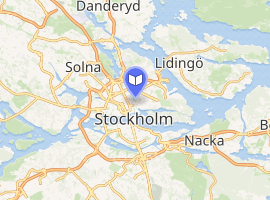National Library of Sweden
The National Library of Sweden (Swedish: Kungliga biblioteket, KB, meaning "the Royal Library") is Sweden's national library. As such it collects and preserves all domestic printed and audio-visual materials in Swedish, as well as content with Swedish association published abroad. Being a research library, it also has major collections of literature in other languages.
| Kungliga biblioteket | |
 | |
| Country | Sweden |
|---|---|
| Established | 1661 |
| Reference to legal mandate | The Government Approval Document for The Swedish National Library (available in Swedish) |
| Location | Stockholm |
| Coordinates | 59°20′17″N 018°04′20″E |
| Collection | |
| Items collected | books, journals, newspapers, magazines, films, recorded sound, television, radio, manuscripts, maps, pictures, printed music, ephemera and digital resources |
| Size | Circa 18 million items and 7 million hours of audiovisual material |
| Criteria for collection | Suecana: publications published, broadcast or recorded in Sweden or by Swedish originator or concerning Sweden |
| Legal deposit | Yes, and agreements with publishers |
| Access and use | |
| Access requirements | Free. Registration for loans: be Swedish resident or citizen over 18. (Audiovisual may only be accessed for research purposes) |
| Circulation | 135, 187 (2009) |
| Other information | |
| Budget | 364,455,000 SEK (2015)[1] |
| Director | Karin Grönvall (since 2019) |
| Staff | 340 |
| Website | www.kb.se |
| Map | |

| |
Collections

The collections of the National Library consist of more than 18 million objects,[2] including books, posters, pictures, manuscripts, and newspapers.[3] The audio-visual collection consists of more than 7 million hours of recorded material.
The National Library is also a humanities research library, with collections of foreign literature in a wide range of subjects. The library holds a collection of 850 broadsides of Sweden dating from 1852.[4]
The National Library also purchases literature about Sweden written in foreign languages and works by Swedes published abroad, a category known as suecana. The National Library has been collecting floppy disks, CR-ROMs, and other electronic storage media since the mid-1990s, along with e-books, e-journals, websites, and other digital material.
In 1953, the National Library purchased considerable amounts of Russian literature from Leningrad and Moscow. These books were to form the basis of a Slavonic library in Stockholm. These plans were consolidated in an agreement made in 1964 between the Lenin Library in Moscow and the National Library in which the respective libraries agreed to exchange their countries' literature.
Legal deposit
According to the Swedish Legal Deposit Act publishers of printed material must send one copy of every object to the National Library and six other research libraries. Publishers of music, film, radio and TV must similarly submit copies to the library. In some cases only a sample of broadcast material has to be submitted.
In 2012, the Legal Deposit Act for Electronic Material was passed. It states that starting in 2013, publishing companies and public authorities must deliver digitally published content to the National Library.
History

The obligation to collect all printed works in Swedish was laid down in 1661 in an ordinance from the Swedish Privy Council Chancery. The ordinance (legal deposit) ordered all printers in Sweden to send two copies of every publication printed to the Chancery before the material was distributed. One copy was to go to the Swedish National Archives (Riksarkivet), the other to the National Library. The motive for this provision stemmed not from a desire to preserve publications for posterity but from a desire to monitor their contents.
Library cooperation
The library is responsible for coordinating all Swedish libraries, including public libraries.
The National Library is responsible for supplying information to higher education and research, which includes obtaining central license agreements for research and university libraries to increase access to various databases. The National Library developed and maintains LIBRIS, the national library database system. LIBRIS is freely available to the public via the Internet and contains more than five million titles held in 300 Swedish libraries. The Swedish ISBN Agency is a unit within the National Library. It is responsible for assigning ISBNs having Sweden's country prefix of 91- (and 978-91-).
The library is a partner of the World Digital Library.[4]
Visits
Anyone may use National Library services, but people must be at least 18 to request and order materials from the collections. Items in the Swedish collection cannot be borrowed for home use and must be read in one of the reading rooms.
The National Library is located in Humlegården in central Stockholm. The correct written form of the name is “The National Library of Sweden” or in Swedish, "Kungliga biblioteket".
History
The roots of what we now know as the National Library go back to the days of King Gustav Vasa in the 16th century. The king collected books on a variety of subjects including history, science, and theology, as well as maps. The collections were expanded by Eric XIV, Johan III, and Charles IX and kept in the palace known as Tre Kronor (The Three Crowns). Some books were purchased abroad, while others were confiscated from Swedish monasteries dissolved in the Protestant Reformation. King Gustavus Adolphus gave away parts of the royal book collection in 1620: those books were the foundation of the Uppsala University Library.
The collection was also expanded through booty taken during the Thirty Years War. These captured treasures included the episcopal library of Würzburg in 1631, the University of Olomouc library in 1642, and the royal library of Prague in 1649. It was in this connection that the 13th-century “Devil's Bible” (the Codex Gigas) came to Stockholm. Queen Christina took much of this material with her to Rome after she abdicated the Swedish throne, but the royal collections continued to grow during the reign of Charles X Gustav through additional spoils of war and purchases abroad. The manuscript collection also includes the Anglo-Saxon Stockholm Codex Aureus.
Under the Chancery Decree of 1661, all book printers in Sweden were required by law to submit two copies of everything they printed – one copy for the National Archives and the other for the National Library. Rather than to acquire newly published literature for research purposes, the decree reflected the desire of a great power to exert state control and censorship.
Much of the library went up in flames during the great palace fire of 1697 when 17,286 bound volumes and 1,103 manuscripts were lost. Only 6,700 volumes and 283 manuscripts survived. Thereafter, the books were stored temporarily in various noble palaces in Stockholm, first in Count Lillie’s house on what was then Norrmalm Square (1697–1702), and later in the Bonde Palace (1702–1730), and Count Per Brahe’s house on Helgeandsholmen (1730–1768). Finally, in 1768, the collections could be moved into the northeast wing of the new royal palace.
The collection grew further in its new home when the Antiquities Archive was dissolved in 1780 and most of the books kept there were transferred to the National Library. In 1792, Gustav III donated his private library of 14,500 works and four years later, Gustav IV Adolf donated 7,500 works. As a result, the National Library owned about 40,000 works by 1814.
Several large book collections, either donated or purchased, came to the National Library in the 19th century. Space was limited in the palace and a new home for the collections was required. In 1877, the National Library moved into new, dedicated premises in Humlegården. The library began installing electric lighting in 1887, but the library was not fully electrified until 1964.
Book thefts
In 2004, it was discovered that dozens of rare books from its collection had been stolen.[5] The subsequent investigation revealed that the thief was Anders Burius, a senior librarian working at the National Library. At least 62 books were stolen and only a few have been recovered, some with the aid of FBI.[5][6] Some of the books still missing are works by Johannes Kepler, Thomas Hobbes, and Christiaan Huygens. The library maintains a list of the missing books.[7]
The building
At first, the royal book collections were kept in the Royal Palace (Tre Kronor), which burned down in 1697. The National Library moved into its current building in Humlegården in December/January 1877/1878. The building was designed by Gustaf Dahl and built using cast iron. Two wings were added in 1926-27.
The National Library was reopened in spring 1997 after comprehensive remodeling and additions. Two large underground stacks, which were built into the bedrock below the building, now contain the bulk of the library's collections, while library patrons, other visitors, and employees share the space in the main building.
The new section, called the Annex, contains auditoriums, exhibition rooms, and a newspaper reading room. Many Swedish daily newspapers and a large number of foreign newspapers are available on microfilm and in a digital search tool in the Microfilm Reading Room.
Organization
The National Library is a state agency that reports to the Ministry of Education and Research. Gunilla Herdenberg has been the National Librarian of Sweden since March 2012.
Audiovisual media
Until 2009, the Swedish National Archive of Recorded Sound and Moving Images collected and archived audiovisual material. In 2009, the archive became a part of the National Library and ceased to be an independent institution.
Digital collections
Beginning 24 March 1997, the National Library also archived the Swedish part of the World Wide Web as part of a project called kulturarw3 (a play on words; kulturarv is Swedish for cultural heritage). Initially, the contents were not available to the public due to copyright issues, but after 2004 visitors to the library could access the archive from dedicated read-only computers on library premises.
In 2010, mass digitization of Swedish newspapers began, and as of 2016, over 12 million pages had been processed.[8][9]
The library is also engaged in the automated collection of electronic resources including e-books and digital print editions from publishers of newspapers and periodicals. An extensive project to digitize physical material at risk of destruction is also in progress.
See also
References
- "Kungl. bibliotekets årsredovisning 2015" (PDF). National Library of Sweden (in Swedish). Retrieved 1 October 2016.
- "Our Collections - Kungliga biblioteket". Retrieved 2013-02-10.
- "National Library of Sweden - information folder" (PDF). National Library of Sweden. 22 October 2015. Retrieved 18 August 2016.
- "The Old People Mill". World Digital Library. 1852. Retrieved 2013-06-30.
- Cohen, Patricia (23 July 2013). "National Library of Sweden to Recover Stolen Books". New York Times. Retrieved 18 August 2016.
- "United States Returns Stolen Antique Books to the National Library of Sweden". Federal Bureau of Investigation. 17 June 2015. Retrieved 19 August 2016.
- "List of missing books stolen from the National Library of Sweden 1995-2004". National Library of Sweden. Retrieved 19 August 2016.
- Heidi Rosen; Torsten Johansson; Mikael Andersson; Henrik Johansson. "Experiences from Digidaily" (PDF). Unesco. Retrieved 25 August 2016.
- "Page count query". tidningar.kb.se. National Library of Sweden. Retrieved 25 August 2016.
External links
| Wikimedia Commons has media related to Kungliga Biblioteket. |
- National Library of Sweden, official site in English
- Twitter account (English)
- Kulturarw3, description of the Kulturarw3 project
- LIBRIS Swedish union library catalogue
- Swedish Media Database (SMDB)